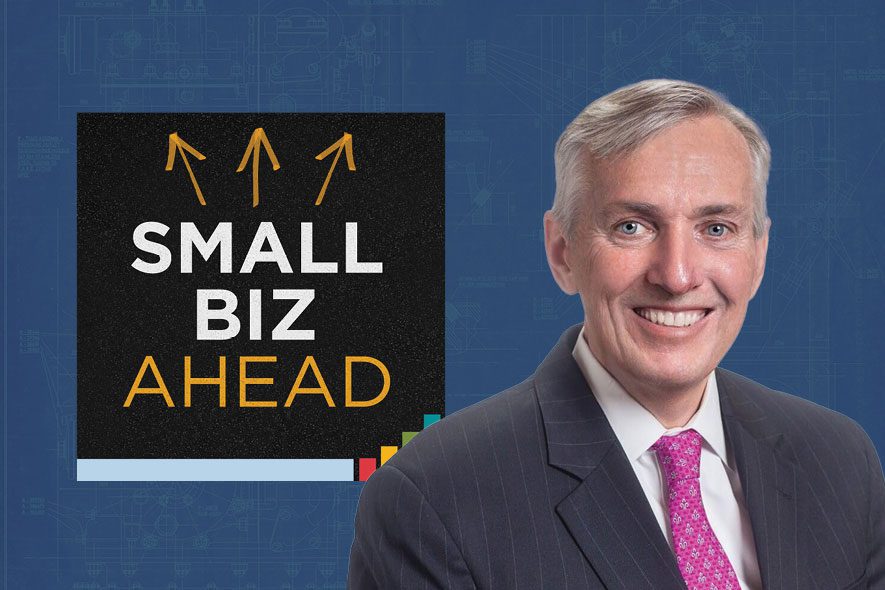Key Podcast Highlights
What Are Five Myths About Credit?
Myth 1: Lines of credit are not ok. In fact, lines of credit are completely fine. A lot of businesses use their line of credit to purchase inventory that they can sell in the next 30 to 60 days.
Myth 2: Lines of credit stay open forever. Lines of credit do not have to stay open forever. However, you should connect your line of credit to your checking account. That way any balance in your checking account goes toward paying down the line of credit. For example, if you have a $1,000 line of credit attached to your checking account, it will be automatically paid off when $2,000 comes into your account from sold inventory.
Myth 3: You shouldn’t be paying attention to interest rates. That’s wrong, you should be. Interest rates for lines of credits are going to be higher than long term fixed rates. They’re variable rates. They are going to fluctuate a lot. When rates are higher, it can get expensive.
Myth 4: Once you have a line of credit, you’re stuck with it. You’re always going to be paying the higher rates. This is incorrect. You can convert your line of credit to a long-term loan at a fixed rate.
Myth 5: You don’t need collateral for a line of credit. In fact, a line of credit must be collateralized against something. It’s normally collateralized against accounts receivable and inventory because that’s what you’re using it for.
Transcript
The views and opinions expressed on this podcast are for informational purposes only, and solely those of the podcast participants, contributors, and guests, and do not constitute an endorsement by or necessarily represent the views of The Hartford or its affiliates.
You’re listening to the Small Biz Ahead podcast, brought to you by The Hartford.
Our Sponsor
This podcast is brought to you by The Hartford. When the unexpected strikes, The Hartford strikes back for over 1 million small business customers with property, liability, and workers compensation insurance. Check out The Hartford’s small business insurance at TheHartford.com.
Gene (00:02):
Hey everybody, this is Gene Marks and welcome to another episode of the Hartford Small Biz Ahead podcast. Thank you so much for joining me. Let’s talk this week about getting a working capital loan or a line of credit from your bank. There are five myths that I think about working capital loans or lines of credits, from banks. Whenever I talk to clients, sometimes they say like, “Oh, I don’t know if I should be getting a loan. Maybe a loan is a bad thing or they’re too expensive or I don’t know if I can handle it.” People have this unrealistic point of view when it comes to lines of credit from your bank and you really shouldn’t have them. I mean, lines of credit are, okay. So, lemme tell you what the myths are, okay?
Gene (00:46):
Myth number one, lines of credit are not okay, that’s a myth. Lines of credit are completely fine. I have many clients that have lines of credit, or again, sometimes the revolving working capital loans. A line of credit is basically an open line that the bank gives you. It’s, it’s very short term. It’s not at a fixed rate. It’s usually at a variable rate of interest. I’ll talk about that in a minute. It’s available for you to use. Listen, I mean, a lot of businesses, a lot of my clients, they use their line of credit to purchase inventory so that they can sell. So there is, if you are running a business, oftentimes you don’t have enough capital for the day-to-day stuff. You need money to buy things that you’re gonna turn around and sell within the next 30 or 60 days, whether it’s inventory or a special project or some type of a thing that you’re working on where you’re like, okay, I need the cash now, but I know I’m gonna convert that money I’m spending, I’m gonna convert it into an invoice and cash coming in, and that’s what I’m gonna pay it off.
Gene (01:47):
So, it’s fine to have a line of credit. It’s completely good to borrow money from a bank for a short term to buy something or to hire somebody or to finance a project. When you know that you’re gonna get paid for that project and you’ll be able to pay off the line of credit, it’s fine. That is why people have line of credits. Now, number two, a line of credit sometimes stays open forever. That’s also a myth. It doesn’t have to stay open forever. In fact, if you’re going to set up a line of credit, make sure that you connect it to your checking account. It should be a revolving line, which basically means that whatever balance that you have left over in your checking account goes towards paying down the line. So you have a net number. That way you don’t have to worry about paying it down, or did I make the payments? Or is it outstanding for too long, or did I forget about it? Or am I paying too much interest? No. If you are using a line of credit for a thousand dollars to buy a thousand dollars worth of inventory, fine, you go into debt for the thousand, but then hopefully within the next 30 to 60 days, you’ve sold that inventory for $2,000. So when the $2,000 comes in, it automatically pays off your line of credit with the funds that are in your…
Gene (02:59):
Checking account. So connect your line of credit to your checking account as a revolving sort of line. That way you can always make sure that you’ll be paying it down and it won’t be outstanding for too long. Number three, a myth about lines of credit is that interest rates, you shouldn’t be paying attention to it, and that’s wrong. You should be. Interest rates for line of credits are going to be higher than long-term fixed rates. They’re variable rates and they are going to fluctuate a lot. Now, when rates are really low, it’s like free money. It’s great stuff, but when rates are higher, it can get pretty expensive. So remember, you’re always gonna have something outstanding on your line of credit. So you wanna make sure that you’re paying attention to the interest rate, you’re making sure it’s getting paid down and you’re constantly asking your banker and negotiating a lower interest rate where possible.
Gene (03:48):
Keep your banker honest, make sure those rates are being adjusted as the prime rate and other rates are being adjusted as well. Okay? Number four, once you have a line of credit, you’re stuck with it. You’re always gonna be paying those higher rates. That’s wrong. You can convert your line of credit to a long-term loan if you really see the need to do that. Sometimes people get a line of credit and it was overused or was used for a purpose, not necessarily for short term working capital. Maybe it dipped into it to buy a piece of equipment or something longer term. Okay? Talk to your banker and take that portion and convert it into a long term loan. Hopefully you have good credit and you’ve got some collateral, which I’ll talk about in the minute.
Gene (04:30):
But you can refinance your line of credit into something longer term at a fixed rate. Hopefully that’s even lower and therefore be able to use it over the longer term and free up your working capital line of credit. Finally, you don’t need collateral for a line of credit. You do. That’s a myth. Having a line of credit means it’s gotta be collateralized against something. It’s normally collateralized against accounts receivable and inventory, because theoretically that’s what you’re using it for. And the bank is gonna be asking you every month to report to them what your accounts receivable and your inventory amounts are, so that they know that they’re not getting into two trouble. You have an overextended yourself. So yes, you are going to need collateral with a line of credit. So let’s go through these five myths one more time. Myth number one, line of credits are not okay.
Gene (05:18):
Wrong, line of credits are, okay. Very common. Use it for short term financing. It is something that you can use to buy inventory or hire people or for projects. I have many clients that use them all the time. Going into debt is not a bad thing because you’re gonna pay it back right away. It’s just a short term thing. Number two, lines of credits are difficult to pay back. No, they’re not. Tie your line of credit to your checking account to make it a revolving line of credit. So whatever cash available and your checking account goes to paying down the lines, you’re paying less interest. Number three, interest rates don’t matter. Yeah, they, they matter a lot. Always keep a close eye on them. It’s a variable rate. It’s usually higher. You wanna be negotiating that with your bank all the time to make sure you’re getting the lowest rate possible on your line of credit.
Gene (06:03):
Number four, lines of credit are gonna be around forever. I can’t convert them to a long-term loan. That’s incorrect. You can convert a line of credit into a longer term loan if you use that line of credit for things like equipment or something longer term. That way you can get a fixed rate and a longer maturity period. And finally, you don’t need collateral for a line of credit. That’s also a myth. You will need collateral. It is generally going to be your inventory in your accounts receivable, although you might have to personally guarantee it as well. Offering up collateral is pretty standard for lines of credit, particularly with small businesses. Those are the five myths that I hear the most from my clients when it comes to lines of credit. If you think it’s good for you, go for it. That’s why they’re there. Many people use them, very common in business. It could be a really great source of capital for you to grow your business. Talk to your banker about them. I hope this information helps. My name is Gene Marks, and you’ve been listening to The Small Biz Ahead podcast. If you want any advice or tips or help in running your business, please visit us at smallbizahead.com or SBA.thehartford.com. Again, my name is Gene Marks. Thanks for listening. We will see you again next week. Take care.
Download Our Free eBooks
- Ultimate Guide to Business Credit Cards: The Small Business Owner’s Handbook
- How to Keep Customers Coming Back for More—Customer Retention Strategies
- How to Safeguard Your Small Business From Data Breaches
- 21 Days to Be a More Productive Small Business Owner
- Opportunity Knocks: How to Find—and Pursue—a Business Idea That’s Right for You
- 99 New Small Business Ideas





